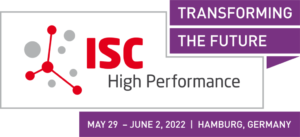 ISC High Performance 2022 is finally here! After two years of online ISC, people can finally get together and talk face to face (albeit with one or two layers of mask tissue in between). The first “full conference” day (Sunday is traditionally reserved for tutorials) marks some notable events this year.
ISC High Performance 2022 is finally here! After two years of online ISC, people can finally get together and talk face to face (albeit with one or two layers of mask tissue in between). The first “full conference” day (Sunday is traditionally reserved for tutorials) marks some notable events this year.
After a warm welcome and introduction by ISC22 Program Chair Keren Bergman, Rev Lebaredian (NVIDIA) and Michele Melchiorre (BMW) gave an enthralling keynote about how digital twins are used in industry and how they may become the one thing that you never knew about but desperately need. A digital twin is like a computational model of reality – be it a manufacturing plant, a building, or even a whole city. Such twins are used a lot in design phases, but they are rarely kept up to date over the whole life cycle of the structures they describe. With the advent of powerful AI methods, this may change as AI could close the gap between model and reality. Rev even went so far as to speculate that, given enough computing power, one could use the twin to move back and forth in time for improved insight, forecasting, or decision making.
An emotional moment (well, for a technical event at least) came with the special session for celebrating the life and work of Jack Dongarra, recipient of the 2021 ACM Turing Award. Horst Simon, Tony Hey, David E. Keyes, and Satoshi Matsuoka recalled Jack’s many achievements, the most prominent of which are the BLAS and LAPACK libraries (and their more current descendants), the initial seedling of the MPI standard, sustainable and scalable HPC benchmarks, and numerous contributions to mixed-precision linear algebra methods.
Next came Erich Strohmaier with his long-awaited presentation of the June 2022 Top500 list, in which he analyzed current trends in supercomputing using the historical data that is now available since 1993. One surprising fact about the current list is that there was never such a low turnaround – only 39 systems fell out of the list, and the entry threshold of just above 1.6 Pflop/s hasn’t even changed. On the positive side, Fritz and Alex, the new NHR@FAU systems, are officially on it: Fritz is at #323, despite some network hardware still missing, and Alex is at #184 although the more than 300 NVIDIA A40 GPUs could not even be used for running LINPACK. In addition, Alex struck #16 in the Green500, in which energy efficiency in Gflop/W determines the ranking. With that, Alex is the most energy-efficient system in Germany.
Oh yes, and there’s a new #1: “Frontier” at Oak Ridge National Lab broke the Exaflop barrier. We have now officially entered the age of exascale, at least if we use the debatable LINPACK metric as the yardstick. Erich pointed out that Frontier now encompasses 25% of the total aggregated Top500 performance; grain-of-salty extrapolations indicate that this ratio may go up to 50% in 2030, but who knows which marvels await behind the closed doors of Nvidia, Intel, or AMD labs.